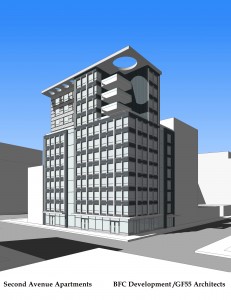
- Courtesy – GF55 Architects
Developers would offer home ownership opportunities to low-income tenants displaced by twelve-story project. On February 16, 2011, the City Planning Commission heard testimony on the Department of Housing Preservation and Development’s proposal to allow BFC Partners and the Urban Homesteading Assistance Board (UHAB) to build a twelve-story affordable housing development in the East Village. The 65-unit project would replace two mixed-use buildings at 9 through 17 Second Avenue between East 1st and East Houston Streets. Thirteen apartments would be permanently affordable and marketed to households earning up to 80 percent of the area median income, and the remaining 52 would be offered as market-rate rental units. To facilitate the project, HPD requested a UDAAP designation and an amendment to the City’s Inclusionary Housing Program.
BFC owns a three-story building on the site at the corner of Second Avenue and East 1st Street. It is occupied by four residential tenants and two commercial tenants, including the Mars Bar saloon. UHAB owns a five-story building to the south that includes five residential tenants, three vacant units, and vacant ground floor space. BFC and UHAB plan to offer the buildings’ nine residential tenants the opportunity to purchase affordable units in the new building.
At the Commission’s review session, the Department of City Planning’s Arthur Huh stated that UHAB and BFC had purchased their properties from the City through the accelerated UDAAP process in 2001 and 2002, respectively. Both transfers included deed restrictions limiting the developers to rehabilitation of the existing buildings or the construction of new one- to four-unit dwellings. Because the current proposal exceeded these limitations, a new application and public review was required.
Huh also stated that the Inclusionary Housing Program only provides a mechanism that permits displaced tenants to return to a building after it has been rehabilitated. A similar mechanism, however, does not exist for tenants whose building would be demolished and replaced by a new building. The proposed amendment would explicitly permit the nine existing tenants to return to and purchase apartments in the planned development.
At the Commission’s February 16 hearing, HPD’s Sara Levenson described the homeownership option, stating that if one of the nine existing tenants failed to meet the 80 percent area median income eligibility threshold, they could choose to lease one of the affordable units. Jenna Breines, director of the Inclusionary Housing Program at HPD, testified that the affordable units would be sold to the existing tenants for ten dollars. The four remaining affordable units would be sold to income-eligible individuals for $180,000 each.
A representative for Manhattan Borough President Scott M. Stringer, who supported the proposal, noted that the homeownership plan would recognize the “sweat equity” the tenants had invested in their buildings over the years. There were no speakers in opposition.
The Commission approved the plan at its March 2 meeting.
CPC: Hearing on 9-17 Second Avenue (C 110140 HAM – UDAAP); (C 110141 PQM – acq. prop.); (N 110165 ZRM – text amend.) (Feb. 16, 2011) (Architect: GF55 Partners).

